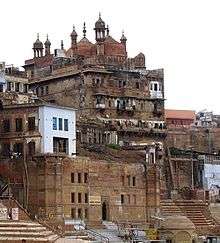Alamgir Mosque, Varanasi
| Alamgir Mosque, Varanasi Beni Madhav ka Darera Aurangzeb's Mosque | |
|---|---|
 | |
 Location in Uttar Pradesh, India | |
| Basic information | |
| Location | Varanasi, India 25.31 N 83.01 E |
| Geographic coordinates | 25°18′40″N 83°00′36″E / 25.311°N 83.01°ECoordinates: 25°18′40″N 83°00′36″E / 25.311°N 83.01°E |
| Affiliation | Islam |
| State | Uttar Pradesh |
| Ecclesiastical or organizational status | Functional |
| Architectural description | |
| Founder | Aurangzeb |
The Alamgir Mosque, Varanasi, also known as Beni Madhav ka Darera and Aurangzeb's Mosque, is a mosque built in the 17th century by emperor Aurangzeb over the ruins of a Hindu temple in Varanasi in the Indian state of Uttar Pradesh.[1][2]
Location
The mosque is located at a prominent site above the Panchganga Ghat. The ghat has broad steps that go down to the Ganges.[3]
History
Dedicated to Lord Vishnu, the Hindu temple, built by Beni Madhur Rao Scindia, a Maratha chieftain, was demolished when the emperor Aurangzeb had captured Banaras and had then ordered the total destruction of all its Hindu temples. Aurangzeb then built a mosque over the ruins of the temple in 1669[4] and named it as Alamagir Mosque in the name of his own honorific title "Alamgir", which he had adopted after becoming the emperor of the Mughal empire.[5][6]
Non-Muslims are not allowed to enter the mosque.[7] The mosque has a security cordon ensured by the police.[8]
Features
The mosque built over the ruins of a Hindu temple is architecturally a blend of Islamic and Hindu architecture, particularly as the lower part of the walls of the mosque were built entirely from the remains of the Hindu temple.[5] The mosque has high domes and minarets.[9][6] Two of its minarets were damaged; one minaret collapsed killing a few people and the other was officially brought down owing to stability concerns.[6] The Panchaganga Ghat where the mosque is situated is where five streams are said to join. In October lamps are lighted on top of a bamboo staff as a mark of guidance to the ancestors.[9]
References
- ↑ Gupta 1987, p. 38.
- ↑ Crowther, Raj & Wheeler 1984.
- ↑ Hussain 1999, p. 70.
- ↑ Dunlop, Sykes & Jackson 2001, p. 135.
- 1 2 Kumar 2003, p. 90.
- 1 2 3 Betts & McCulloch 2013, p. 213.
- ↑ Fodor's essential India : with Delhi, Rajasthan, Mumbai & Kerala. New York: Fodor's. 2015. ISBN 9781101878682.
- ↑ Vit-Suzan 2014, p. 11.
- 1 2 Shetty 2014, p. 73.
Bibliography
- Betts, Vanessa; McCulloch, Victoria (27 September 2013). India – The North: Forts, Palaces, the Himalaya Dream Trip. Footprint Travel Guides. ISBN 978-1-907263-74-3.
- Crowther, Geoff; Raj, Prakash A.; Wheeler, Tony (1984). India, a Travel Survival Kit. Lonely Planet.
- Dunlop, Fiona; Sykes, Carol; Jackson, Felicity (2001). Fodor's Exploring India. Fodor's Travel Publications. ISBN 978-0-679-00707-4.
- Hussain, Ansar (1 January 1999). Rediscovery of India, The: A New Subcontinent. Orient Blackswan. ISBN 978-81-250-1595-6.
- Kumar, Brajesh (2003). Pilgrimage Centres of India. Diamond Pocket Books (P) Ltd. ISBN 978-81-7182-185-3.
- Shetty, Rekha (1 May 2014). Innovation Sutra: The Secret of Good Business and a Good Life. Penguin Books Limited. ISBN 978-93-5118-696-0.
- Vit-Suzan, Dr Ilan (28 March 2014). Architectural Heritage Revisited: A Holistic Engagement of its Tangible and Intangible Constituents. Ashgate Publishing, Ltd. ISBN 978-1-4724-2064-0.